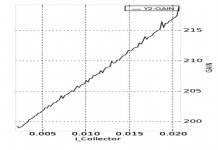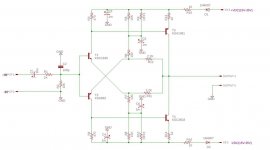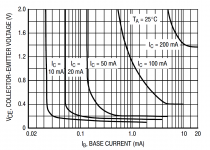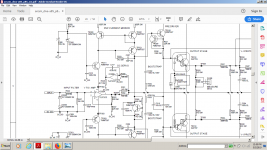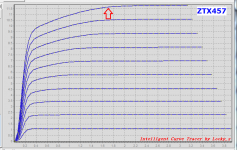BD441
Since the BD437 was mentioned, I acquired some BD441 which are the 80V verison of the BD437.
Quasi sat behavior is good but Early voltage is visibly less good.
At 10-ish mA IC, Early voltage of the BD441 is less than 60 while at the same-ish Ic and same Vce, the TTC004B has an Early voltage of just under 700.
Since the BD437 was mentioned, I acquired some BD441 which are the 80V verison of the BD437.
Quasi sat behavior is good but Early voltage is visibly less good.
At 10-ish mA IC, Early voltage of the BD441 is less than 60 while at the same-ish Ic and same Vce, the TTC004B has an Early voltage of just under 700.
Attachments
That's why I ultimately chose a cascode (link)
With an incremental output resistance (dV/dI) of 6 megohms at 8 mA DC current, that's an equivalent Early voltage of 48 kilovolts.
Yes, I can see why. A cascode version of what I am working on will definitely be happening.
BD139/BD140
I just built a pcb using the BD139/BD140 to compare to the previous KSC3503E/KSA1381E.
With the BD139/BD140, with + / - 35V rails, I get a very nice 70v p-p 10kHz square wave out. Much, much nicer than the KSC3503E/KSA1381E. No crossover distortion of the triangle wave, either.
Max unclipped triangle wave is 66v p-p.
Input transistors are Toshiba 2SC2240BL/2SA970BL.
Input and output transistors all have very good quasi-sat behavior.
Circuit built is attached.
I just built a pcb using the BD139/BD140 to compare to the previous KSC3503E/KSA1381E.
With the BD139/BD140, with + / - 35V rails, I get a very nice 70v p-p 10kHz square wave out. Much, much nicer than the KSC3503E/KSA1381E. No crossover distortion of the triangle wave, either.
Max unclipped triangle wave is 66v p-p.
Input transistors are Toshiba 2SC2240BL/2SA970BL.
Input and output transistors all have very good quasi-sat behavior.
Circuit built is attached.
Attachments
Pete, the datasheet shows a complementary device part#. But that PNP component is out of stock at every single distributor indexed by octopart.com, AND the same is true for findchips.com.
I have 70 of each and will send him half a dozen if needed.
I think we should do a group buy of the parts at Rochester.
I think we should do a group buy of the parts at Rochester.
I have 70 of each and will send him half a dozen if needed.
I think we should do a group buy of the parts at Rochester.
Do you want your parts curve traced? I would be happy to do so.
As Mark stated, the complements are unobtanium, so I passed on buying any of the parts that are available. For me, the On Semi BD139/140 and the Toshiba TTC004/TTA004 are enough to keep me busy for a while.
As an aside, Arrow has slightly cheaper prices than Mouser and Arrow gives free overnight shipping. Very dangerous for me. I have no affiliation with Arrow.
As Mark stated, the complements are unobtanium
Not really, just wait until middle of september, and You can get them...
Sajti
Less good, but still clean above 1V, so usable. The 3503 is terrible, is this typical for 300V parts, as they have to have a thick base region to get the breakdown?
I just built a pcb using the BD139/BD140 to compare to the previous KSC3503E/KSA1381E.
With the BD139/BD140, with + / - 35V rails, I get a very nice 70v p-p 10kHz square wave out. Much, much nicer than the KSC3503E/KSA1381E. No crossover distortion of the triangle wave, either.
Max unclipped triangle wave is 66v p-p.
Input transistors are Toshiba 2SC2240BL/2SA970BL.
Input and output transistors all have very good quasi-sat behavior.
Circuit built is attached.
Zetex has the best transistors for low sat in every range.
ARCAM DIVA-A85 P85 SM Service Manual download, schematics, eeprom, repair info for electronics experts
try also ztx 1051, 1149, 1055, 951, 651, 851, 751...
Leave Nelson Pass thread clean of your measurements , please!
Attachments
2SC3503 Quasi Saturation
I’m thinking there may be a little too much bashing of the 2SC3503 without enough context. The Ic vs. Vce curves presented do show some concerning amount of quasi saturation, a larger amount of which can often be expected in a high-voltage transistor optimized for high ft and low capacitances. Pick your poison. But the important thing is how much distortion results in the actual amplifier and what circuit environment/topology exists in the amplifier.
I use the 2SC3503 and its complement frequently in my power amplifiers for the VAS and pre-drivers, and achieve very low values of distortion up to just below clipping with +/- 55-V rails with global feedback taken from the pre-driver emitters so that output stage distortion is a separate matter. This includes THD-20. Output stage distortion always dominates in the complete amplifier, as expected. These amplifiers inevitably include a 2T VAS and an output Triple. I always bias the VAS at about 10 mA and degenerate it with 22 ohms. ULGF is usually 1 MHz. I usually do not cascode the VAS.
I measured a random KSC3503 at base current values of 100uA and 150uA at Vce ranging from 0.5V to 10V. Beta at 10V at both Ib = 100uA and 150uA was 133, with Ic at 13.3 and 20 mA, respectively. Beta was still 123 and and 110 at Vce=3V. It was down to 112 and 99 at Vce=2V. It was down to 97 and 85 at 1V. This is really not that bad, with very significant current gain remaining even at Vce=1V.
Circuits with less dependence on current gain, like those where the 2SC3503 is preceded by an emitter follower in a 2T VAS, will be much more immune to these effects, especially if there is some emitter degeneration. Similarly, in designs where the VAS is not run at current well in excess of 10mA and where current swing is not large (as with a Triple output stage) modest variations in current gain with Vce swing will not be problematic. Finally, a VAS with shunt Miller compensation (providing local feedback) will also create less distortion as a result of reduced Early voltage at low Vce.
On the other hand, open-loop line-level circuits may be better served by a different transistor.
Bottom line: no problem using a 2SC3503 in a properly designed power amplifier. As always, just my opinion based on real-world experience.
Cheers,
Bob
I’m thinking there may be a little too much bashing of the 2SC3503 without enough context. The Ic vs. Vce curves presented do show some concerning amount of quasi saturation, a larger amount of which can often be expected in a high-voltage transistor optimized for high ft and low capacitances. Pick your poison. But the important thing is how much distortion results in the actual amplifier and what circuit environment/topology exists in the amplifier.
I use the 2SC3503 and its complement frequently in my power amplifiers for the VAS and pre-drivers, and achieve very low values of distortion up to just below clipping with +/- 55-V rails with global feedback taken from the pre-driver emitters so that output stage distortion is a separate matter. This includes THD-20. Output stage distortion always dominates in the complete amplifier, as expected. These amplifiers inevitably include a 2T VAS and an output Triple. I always bias the VAS at about 10 mA and degenerate it with 22 ohms. ULGF is usually 1 MHz. I usually do not cascode the VAS.
I measured a random KSC3503 at base current values of 100uA and 150uA at Vce ranging from 0.5V to 10V. Beta at 10V at both Ib = 100uA and 150uA was 133, with Ic at 13.3 and 20 mA, respectively. Beta was still 123 and and 110 at Vce=3V. It was down to 112 and 99 at Vce=2V. It was down to 97 and 85 at 1V. This is really not that bad, with very significant current gain remaining even at Vce=1V.
Circuits with less dependence on current gain, like those where the 2SC3503 is preceded by an emitter follower in a 2T VAS, will be much more immune to these effects, especially if there is some emitter degeneration. Similarly, in designs where the VAS is not run at current well in excess of 10mA and where current swing is not large (as with a Triple output stage) modest variations in current gain with Vce swing will not be problematic. Finally, a VAS with shunt Miller compensation (providing local feedback) will also create less distortion as a result of reduced Early voltage at low Vce.
On the other hand, open-loop line-level circuits may be better served by a different transistor.
Bottom line: no problem using a 2SC3503 in a properly designed power amplifier. As always, just my opinion based on real-world experience.
Cheers,
Bob
Zetex has some stinkers. Here's a copy of a figure attached to post #15 above. This Zetex NPN transistor exhibits quasi-saturation (the topic of this thread) below 1.7 volts or so, red arrow.Zetex has the best transistors for low sat in every range.
Leave the NPN transistor quasi-saturation thread clean of your circuit schematics, please.
_
Attachments
Yes, the KSC3503 still has the important advantage of speed, which seems to have a strong negative correlation with low quasi-saturation.
If your rails are at 50V, the last 3V before clipping where quasi saturation starts to matter represent only 0.5% of the total output power. So you don't really lose significant headroom.
If you have 10V rails though, it climbs to 9%. But then it is easy enough to reduce the bias current to avoid quasi-saturation.
If your rails are at 50V, the last 3V before clipping where quasi saturation starts to matter represent only 0.5% of the total output power. So you don't really lose significant headroom.
If you have 10V rails though, it climbs to 9%. But then it is easy enough to reduce the bias current to avoid quasi-saturation.
Last edited:
If your rails are at 50V, the last 3V before clipping where quasi saturation starts to matter represent only 0.5% of the total output power. So you don't really lose significant headroom.
That's odd. When I run those numbers, I find the last 3V before clipping represent about 12% of the total output power. If the load is a resistor, output power is proportional to the square of the peak output voltage, so reducing the peak output voltage is bad squared.
Could you show the arithmetic that gives 0.5% of total output power?
Nevermind, you're right. The point is, you don't really lose much headroom from quasi-saturation in this case.
(50V^2-47V^2)/50V^2 = 11.6%
That is less than 1db of output lost.
(50V^2-47V^2)/50V^2 = 11.6%
That is less than 1db of output lost.
Last edited:
Zetex has some stinkers. Here's a copy of a figure attached to post #15 above. This Zetex NPN transistor exhibits quasi-saturation (the topic of this thread) below 1.7 volts or so, red arrow.
Leave the NPN transistor quasi-saturation thread clean of your circuit schematics, please.
_
Did you deliberately chose a trz with a 300mv sat CE when ztx951 has 15mv!!! at the same 100/10ma , while ztx1051 has 17mv at 200/10ma?
Is it something that i don't understand here?I just said that zetex has the lower low sat transistors...and in my schematic there's fmmt497/597 are not low sat but are high voltage and quite unique trz...
I’m thinking there may be a little too much bashing of the 2SC3503 without enough context. The Ic vs. Vce curves presented do show some concerning amount of quasi saturation, a larger amount of which can often be expected in a high-voltage transistor optimized for high ft and low capacitances. Pick your poison. But the important thing is how much distortion results in the actual amplifier and what circuit environment/topology exists in the amplifier.
I use the 2SC3503 and its complement frequently in my power amplifiers for the VAS and pre-drivers, and achieve very low values of distortion up to just below clipping with +/- 55-V rails with global feedback taken from the pre-driver emitters so that output stage distortion is a separate matter. This includes THD-20. Output stage distortion always dominates in the complete amplifier, as expected. These amplifiers inevitably include a 2T VAS and an output Triple. I always bias the VAS at about 10 mA and degenerate it with 22 ohms. ULGF is usually 1 MHz. I usually do not cascode the VAS.
I measured a random KSC3503 at base current values of 100uA and 150uA at Vce ranging from 0.5V to 10V. Beta at 10V at both Ib = 100uA and 150uA was 133, with Ic at 13.3 and 20 mA, respectively. Beta was still 123 and and 110 at Vce=3V. It was down to 112 and 99 at Vce=2V. It was down to 97 and 85 at 1V. This is really not that bad, with very significant current gain remaining even at Vce=1V.
Circuits with less dependence on current gain, like those where the 2SC3503 is preceded by an emitter follower in a 2T VAS, will be much more immune to these effects, especially if there is some emitter degeneration. Similarly, in designs where the VAS is not run at current well in excess of 10mA and where current swing is not large (as with a Triple output stage) modest variations in current gain with Vce swing will not be problematic. Finally, a VAS with shunt Miller compensation (providing local feedback) will also create less distortion as a result of reduced Early voltage at low Vce.
On the other hand, open-loop line-level circuits may be better served by a different transistor.
Bottom line: no problem using a 2SC3503 in a properly designed power amplifier. As always, just my opinion based on real-world experience.
Cheers,
Bob
Hi Bob
Thank you for the explanation. That makes sense. For the circuit that I am exploring, the KSC3503/KSA1381E are one of only two gain stages and are the output stage producing all of the output current. A triangle wave is visibly distorted almost 10V from peak output voltage. The quasi-sat compression is right there for all to see. This problem goes away using a low quasi sat device pair.
As an aside, I recall meeting you at a DC/MD DIY event where we listened to a pair of your powered speakers with your amplifiers inside. Super impressive. You truly do awesome work. I believe that I was dragging around a 6-foot tall ribbon tweeter that day.
cheers
Hi Bob
Thank you for the explanation. That makes sense. For the circuit that I am exploring, the KSC3503/KSA1381E are one of only two gain stages and are the output stage producing all of the output current. A triangle wave is visibly distorted almost 10V from peak output voltage. The quasi-sat compression is right there for all to see. This problem goes away using a low quasi sat device pair.
As an aside, I recall meeting you at a DC/MD DIY event where we listened to a pair of your powered speakers with your amplifiers inside. Super impressive. You truly do awesome work. I believe that I was dragging around a 6-foot tall ribbon tweeter that day.
cheers
Thanks! Those were the days 🙂.
Cheers,
Bob
- Home
- Amplifiers
- Solid State
- Looking for a small signal NPN with no Quasi Saturation: MEASURED DATA

